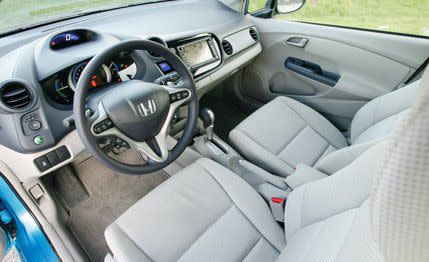2010 Honda Insight vs. Toyota Prius, 1998 Chevy Metro



What we have here is an official C/D comparison test in which the photo vehicle, a Honda Pilot, proved far quicker than any of our contestants. These cars make you feel guilty about eating red meat. Convicted road ragers should be forced to do time in any of these three.
Both hybrids here are brand-new, if not all-new. The Honda Insight, which made its debut in 1999, has undergone the most radical transformation, gaining one cylinder, 25 horsepower, a back seat, and a shape that no longer resembles a tadpole in a spandex body wrap. In fact, what the Insight looks like is the Prius but with a smiling-fish grille instead of the Toyota’s frowning-fish grille.
We drove these mileage maestros on a 600-mile odyssey—a mix of interstates, country two-lanes, urban loops, and hilly whirligigs. The route led us from Ann Arbor through Columbus and ultimately to the southern Ohio towns of Knockemstiff and Tranquility via a side trip to Serpent Mound, a six-foot-tall earthen replica of a huge snake that was either produced by Native Americans 1000 years ago or by a ’50s-era farmer with a strong John Deere and an even stronger sense of humor.
There were no driving rules. Eco mode was not mandated. Using the air conditioner was legal. So were jack-rabbit starts and dangerous cornering speeds, neither of which we were able to accomplish. In short, we drove as we always do, trying to eke out some fun, and our observed fuel-economy figures reflect that. Indeed, that was the whole point of this test—to drive these things the way we’d drive regular cars. The regular-car control group was represented here by a 1998 Chevrolet Metro, and it was exceedingly regular. Funny that both hybrids’ consumption computers were optimistic—the Prius’s by 4 mpg, the Insight’s by 3 mpg. Final note: Knockemstiff didn’t. Tranquility was.
Yes, this is a 1998 three-cylinder Chevy Metro that when new, 110,000 miles ago, didn’t even include hubcaps. It landed in this group as a consequence of a rhetorical question: Might 12-year-old technology producing 55 horsepower in an 1840-pound package satisfy hypermilers? Answer: Not sure. We don’t know any hypermilers.
Let’s start with the Metro’s faults: It takes 20.3 seconds to cover the quarter-mile, roughly twice the average span that Americans will listen to Kenny G before changing channels. Top speed: 87 mph. Amenities? Well, it came originally with oil in the engine, a full tank of gas, two windshield wipers, and a dome light. Fit and finish? Some. Side airbags? Nope, but there are two horn buttons. Steering-wheel adjustment? Negative again, although strategically arranged pillows removed from the Comfort Inn can easily overcome this dilemma.
The perks? The green upshift light serves as the Metro’s eco mode. If you desire a hybrid-like auto-stop feature, merely twist the ignition key counterclockwise—works every time. There’s not one single LED or digital readout on the instrument panel. The shift knob is almost as shiny as the Prius’s (a 12-year patina of Armor All is something everyone should see). The ashtray is real, ready for any flaming embers the Marlboro man might have produced. There’s no key fob to open the doors remotely, but the key is attached to a metal strip featuring a stunning likeness of Jeff Gordon. The steering courteously features four to six inches of on-center slop so your arms never get tired. The HVAC’s slider controls require perhaps two pounds of finger pressure, ensuring no inadvertent selections. There’s not one single piece of fake chrome inside the cabin. There’s a custom-looking, raffish blue stripe atop the cam cover. The tread-wear rating of the tires (420) suggests they might outlast the car itself. And the Metro’s rear strut suspension is more sophisticated than the Insight’s or the Prius’s.
We know folks who own vacuum sweepers more powerful than this eco-wheezer. Big deal. A Smart Fortwo Passion—weighing 25 fewer pounds than the Metro—managed observed economy of 32 mpg. The Metro nailed 42 mpg, equaling the Prius’s best efforts. Metro sexual, baby.
________________________________________

________________________________________
Climbing out of the Insight or the Metro and into this third-gen Prius feels like climbing into a Lincoln Town Car. The Toyota’s interior volumes are up: The back seat is now all-day spacious for two pizza-fed adults, and compared with the Insight, the Prius boasts a bonus six cubic feet of cargo space.
Engine size and battery output have swollen, too, resulting in a combined 134 horsepower. That oughta demolish the wimpy 98-horse Insight, right? Nope. The Prius is 436 pounds fatter and was only 1 mph faster through the quarter-mile.
Toyota has continued to curse this latest Prius with a shifter connected only to electrical circuits, making it as exciting as flipping on the kitchen light. Worse, the shift pattern is Goldbergian: Push left and forward for reverse. Left and down for drive. Between the two, with no detent, is neutral—tricky to locate and notably embarrassing when the carwash guy shouts, “Come on, dude, I said, ‘Put ’er in neutral.’ ” Push straight down for “B,” which summons extra engine braking. And to engage park? Oh, that isn’t possible via the shifter, chief. You gotta press a button on the center console for that.
Then there are three power modes. First, there’s EV for driving with the electric motor alone. This supposedly works for up to one mile “if conditions permit,” warns Toyota. Here’s one condition: We never got farther than about 100 feet before the enraged guy behind us had a fit in his Fit. Second, there’s eco mode, which reduces A/C operation and deadens throttle response until you feel as if you’re pressing the already stiff accelerator pedal about six inches for a gain of 5 mph. Finally, there’s power mode. Until fuel returns to $4 per gallon, you’ll remain in power mode with B (max engine braking) for 90 percent of your Prius occupancy.
We recorded other bummers. The dull-green digits in the instrument panel are difficult to read in bright sunlight. The center stack comprises 30 buttons and switches. And the brakes—depending on how much re-gen they’re facilitating—are hopelessly nonlinear.
In its favor, the Prius offers a cushy ride and is quiet at speed. Its cockpit is filled with amenities, including battery-draining heated seats (in Prius IV trim). It tracks better and is less susceptible to crosswinds than the Insight. And its engine is silkier at max revs, drawing little or no attention as it transitions from auto stop to auto start.
________________________________________

________________________________________
Alas, on southern Ohio’s serpentine roads, the Prius was less a fish out of water than a corpse in a coffin. Body motions were poorly controlled. The Bridgestones and the torsion-beam rear suspension felt overwhelmed. And twirling the steering wheel was like pushing a doughnut through a vat of yogurt: zero on-center feel, numb, nobody home. What’s more, the Prius’s stability control is not only aggressive but can’t be disabled, as if the driver must be denied any semblance of fun. Question: What shall we do when the Prius is stuck in snow?
Delivering an observed 42 mpg, the Prius easily beat the Insight’s fuel numbers (but not the Metro’s), and this hybrid does permit its driver to shout, “Hey, look at my 0.25 coefficient of drag!” Otherwise, what it offers is a smug sense of frugality and an expansive view of nearby motorists having way more fun.
Above the Insight’s instrument panel is an organic-looking eyebrow that contains an eye—well, white digits indicating speed—and behind that is a halo-like iris that slowly changes color. When it’s green, your driving behavior is eco-friendly. When it turns cold blue, you’re driving like Gary Busey. There’s some Big Brotherishness in all of this, but the alternating hues do serve as subliminal reminders that eventually lead to the path of Mother Earth righteousness.
The Insight wins this comparo because it’s more a car than a cocoon-like transport module. Its cloth seats are comfortable, with more lateral support than the Prius’s. The HVAC controls are integrated into one huge rotary knob with easy-to-read icons. There’s a real tach. Offering appropriate heft and satisfactory accuracy, the steering feels connected to actual wheels. The brake pedal is firmer and less quirky by a factor of, oh, five. Body motions are few, the suspension is tight and difficult to disrupt, and someone has even dialed in a touch of lift-throttle oversteer to help rotate that cliff of a tail.
One of the EX model’s most endearing features is its paddle shifters. Pull the left paddle for downshifts, pull the right for upshifts. Of course, this is a CVT, so the “gears” are merely artificial steps, and there are seven of them. Seven? Why not, say, 27? At least then we’d know that Honda was in on the joke. No matter, because in sport mode the transmission is tenacious about holding onto those “gears,” at least until redline. All of which helped keep the engine on the boil in Ohio’s hills, supplied all the engine braking we needed, and lent the driver a sense of involvement and control that was sorely lacking in the Prius.
With an as-tested price of $23,770—including nav—the Insight is also a bargain. Some of that cost cutting, however, came at the expense of sound-deadening materials because this platform is a little overeager to transmit road noise, and its engine, at wide-open whack, is downright gritty, a rare thing to say about any Honda powerplant. The Insight automatically turns off its engine when the car is stopped and your foot is on the brake, then it restarts automatically when you hit the gas. (Unlike the Prius, the Insight’s engine is on whenever the car is accelerating.) This auto-stop/auto-start cycle, however, is affected by the level of charge in the batteries, and the batteries, of course, are affected by the number of accessories you may be using—A/C, radio, headlights, fan, and so forth. When the Insight transitions from electric to gas motivation, it evinces a noticeable shiver. After an auto start from rest, in fact, we found it best to wait a sec for the engine to attain a smooth idle before pushing the accelerator very far. Otherwise, the car would lurch.
________________________________________

________________________________________
Oddly, even after 600 miles of driving, we failed to divine what conditions must exist to induce auto stop. We turned off all accessories, yet the engine would sometimes quit at traffic lights, sometimes keep running, and sometimes stop, then restart in a few seconds. It was annoying because the angry blue halo would occasionally glow as we waited through traffic lights, as if commanding us to turn off the damn thing.
Still, the Insight proved more visceral, connected, and agile than the Prius. Its observed 38 mpg was a bit disappointing, although that was partly the outcome of us banging away at the paddles in sport mode, the latter typically spinning the engine 1000 revs beyond eco mode.
The Insight represents a lot of engineering bang for the buck, and the majority of its dynamics are more satisfying than the Prius’s. But if you’re hellbent on a practical Honda, we know one that’s cheaper, quicker, roomier, and still managed an observed 31 mpg: the Honda Fit Sport.
You Might Also Like

 Yahoo Autos
Yahoo Autos 